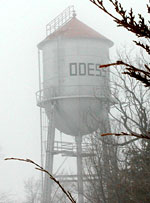Small Towns in Rural Minnesota Are Getting Smaller
By Mark Steil
April 4, 2001
Part of MPR's online coverage of The Faces of Minnesota
Minnesota's 2000 census contained some startling numbers as well as some figures which suprised no one. Population declines in Minnesota's most rural counties continued a trend that's affected the western and northwestern regions of the state the hardest. Every county but one bordering North and South Dakota lost people in the last decade. Most people blame a long term decline in the number of farmers for losses that hit small towns especially hard.
FROM KITTSON COUNTY IN THE STATE'S NORTHWEST CORNER
to Rock in the southwest, the population drops were sharp and ominous. Lac Qui Parle County, down 9.5 percent. Kittson County, 8.3 percent. Marshall County, 7.2 percent. Big Stone, Traverse, Lincoln and Norman each lost about 7 percent of their population, with Pipestone down about 6 percent. Eight of the top 10 Minnesota counties that were big losers in the 2000 census border North and South Dakota. An exception to that pattern is the northern Minnesota county which lost more people than any other - Koochiching County, home to International Falls.
"I was not at all surprised," says Koochiching County commissioner Larry Chezick. The census shows his county lost almost 12 percent of its population the last 10 years. But Chezick says he believes the numbers are suspect.
"The year 1990 was the peak of the Boise Cascade expansion. At that time, sometimes the imported work force numbered as high as 2,500," says Chezick, who believes many of those construction workers were improperly included in the 1990 number, making the 2000 population drop seem bigger than what really occurred.
Unfortunately for the other counties, there are no major counting glitches to blame for the population loss. Most of western Minnesota is in a decades-long decline, and no one knows when it will end.
"All these towns are dying away. It's just going to be nothing but old people living around here," says Leroy Strei, who has lived all his 83 years in Odessa, located in west central Minnesota's Big Stone county. He's seen how the evolving face of rural life changes small towns like Odessa. Strei remembers 60 years ago, when Main Street was booming with two grocery stores, two banks, three elevators, and other businesses.
There's little business left in Odessa these days. A cafe, bar, and grain elevator are still open. A small honey processing business has set up shop, and an artist has converted an old church into a combination studio and sales shop. According to the latest census, Odessa's population is 113 people, down 27 percent in the last 10 years. Strei says the farm decline is one factor hurting the town, but he says it's more complex than that. The social fabric of small Minnesota towns has unraveled, something Strei remembers from his childhood days as a sense of "togetherness."
"We had more fun over little things, like 'pump, pump pull-away' and playing tag, and people would get together," Strei recalls. "That's all gone now. The younger generation all have cars, and they're watching television and movies and all that. Those days will never come back again."
Strei says that sense of togetherness was so pervasive it had a powerful impact on how people acted. He remembers an incident from the 1940s, when a farmer got drunk in Odessa on a Saturday night and was tossed in the city's tiny jail.
"They let him out on Sunday morning, and he was so ashamed of himself he never came back to this town again. He didn't want to show his face," he says.
Strei says the farm decline hurt every business in town, but the automobile also has had a major impact. Cars allowed people easy access to nearby cities like Ortonville, for shopping. The closing of the high school in the 1960s was another blow, since it was the center of the town's social life. Strei admits that an old definition of small town life is no longer true - that it's a place where everyone knows everyone.
"In this little town there are people who've moved in here, and I don't know who they are," he says.
At times, there seems to be almost a conspiracy of technology to divide and break the few bonds that hold the town together. Strei says the silencing of the town's fire alarm even made a change.
"When that whistle would blow, everybody would look to see where the fire truck is going, then they would all get out and follow it. Now they've got pagers, so when they have a fire we don't know it. It's just the firemen who know it. So there's a fire going on around here that I don't even know about because the whistle doesn't blow," says Strei.
But Strei stills like living in Odessa, because the people are friendly and taxes are low. It's the same story in the other small western Minnesota towns. They function more as bedroom communities than anything else. Work, entertainment, shopping are things done in some other city, but the small town is still a good place to call home.
By Mark Steil
April 4, 2001
Part of MPR's online coverage of The Faces of Minnesota
|
|
RealAudio |
Minnesota's 2000 census contained some startling numbers as well as some figures which suprised no one. Population declines in Minnesota's most rural counties continued a trend that's affected the western and northwestern regions of the state the hardest. Every county but one bordering North and South Dakota lost people in the last decade. Most people blame a long term decline in the number of farmers for losses that hit small towns especially hard.
| |
|
|
|
||
"I was not at all surprised," says Koochiching County commissioner Larry Chezick. The census shows his county lost almost 12 percent of its population the last 10 years. But Chezick says he believes the numbers are suspect.
"The year 1990 was the peak of the Boise Cascade expansion. At that time, sometimes the imported work force numbered as high as 2,500," says Chezick, who believes many of those construction workers were improperly included in the 1990 number, making the 2000 population drop seem bigger than what really occurred.
Unfortunately for the other counties, there are no major counting glitches to blame for the population loss. Most of western Minnesota is in a decades-long decline, and no one knows when it will end.
"All these towns are dying away. It's just going to be nothing but old people living around here," says Leroy Strei, who has lived all his 83 years in Odessa, located in west central Minnesota's Big Stone county. He's seen how the evolving face of rural life changes small towns like Odessa. Strei remembers 60 years ago, when Main Street was booming with two grocery stores, two banks, three elevators, and other businesses.
There's little business left in Odessa these days. A cafe, bar, and grain elevator are still open. A small honey processing business has set up shop, and an artist has converted an old church into a combination studio and sales shop. According to the latest census, Odessa's population is 113 people, down 27 percent in the last 10 years. Strei says the farm decline is one factor hurting the town, but he says it's more complex than that. The social fabric of small Minnesota towns has unraveled, something Strei remembers from his childhood days as a sense of "togetherness."
"We had more fun over little things, like 'pump, pump pull-away' and playing tag, and people would get together," Strei recalls. "That's all gone now. The younger generation all have cars, and they're watching television and movies and all that. Those days will never come back again."
| |
|
|
|
||
"They let him out on Sunday morning, and he was so ashamed of himself he never came back to this town again. He didn't want to show his face," he says.
Strei says the farm decline hurt every business in town, but the automobile also has had a major impact. Cars allowed people easy access to nearby cities like Ortonville, for shopping. The closing of the high school in the 1960s was another blow, since it was the center of the town's social life. Strei admits that an old definition of small town life is no longer true - that it's a place where everyone knows everyone.
"In this little town there are people who've moved in here, and I don't know who they are," he says.
At times, there seems to be almost a conspiracy of technology to divide and break the few bonds that hold the town together. Strei says the silencing of the town's fire alarm even made a change.
"When that whistle would blow, everybody would look to see where the fire truck is going, then they would all get out and follow it. Now they've got pagers, so when they have a fire we don't know it. It's just the firemen who know it. So there's a fire going on around here that I don't even know about because the whistle doesn't blow," says Strei.
But Strei stills like living in Odessa, because the people are friendly and taxes are low. It's the same story in the other small western Minnesota towns. They function more as bedroom communities than anything else. Work, entertainment, shopping are things done in some other city, but the small town is still a good place to call home.


